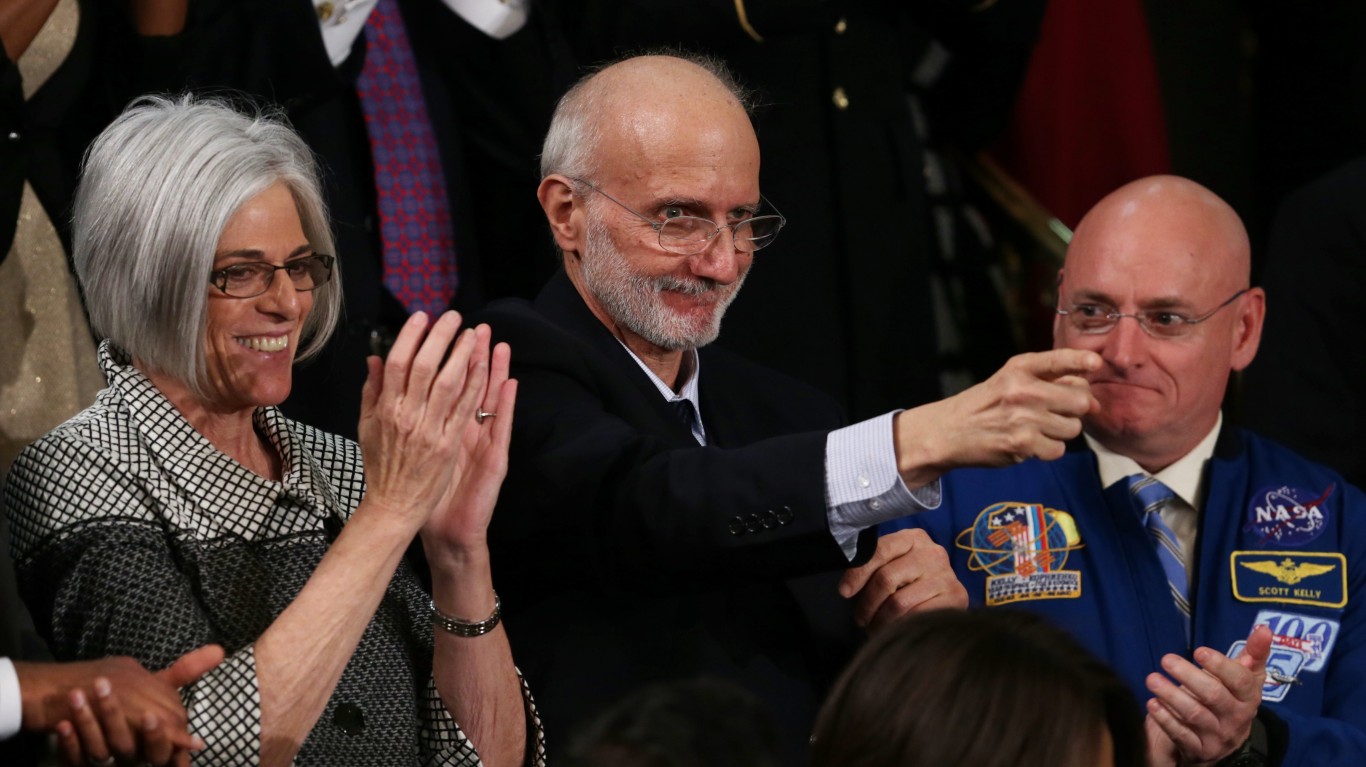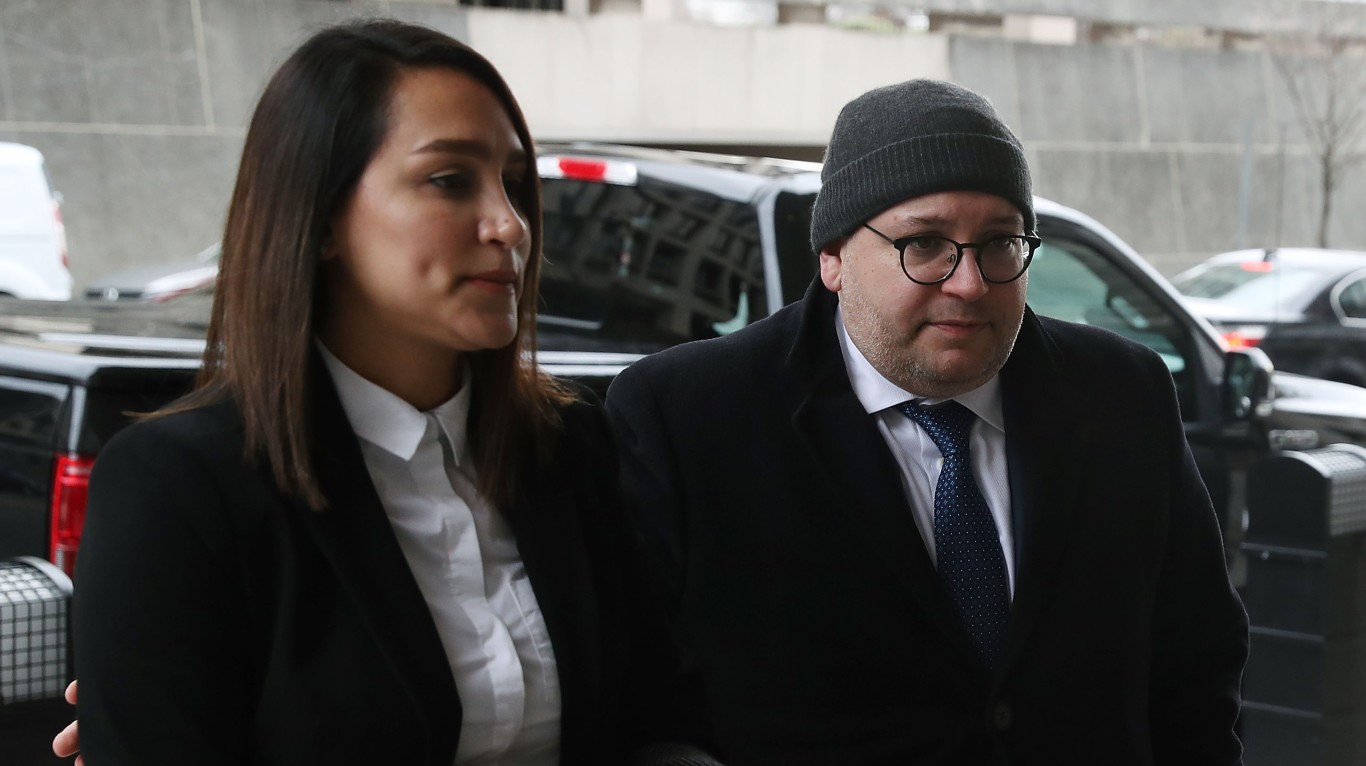
On Dec. 8, 2022, after months of negotiations over her wrongful imprisonment, WNBA star Brittney Griner was exchanged on a tarmac in Abu Dhabi for Russian arms dealer Victor Bout, who had been a prisoner in the U.S.
The Griner-Bout trade was the latest high profile event in a long history of prisoner swaps between the United States and hostile foreign nations. And as the number of wrongfully detained Americans abroad increases – one researcher estimates their number o has risen 175% over the last decade – prisoner swaps may become more common. As of this writing, the United States and Iran are currently working on a deal that would lead to the release of five American citizens.
Using various news and historical sources, 24/7 Tempo compiled a list of some of the most famous prisoner swaps in history. Prisoner exchanges are ordered chronologically, and the list is far from complete.
Some of the most famous prisoner swaps were conducted during the Cold War, when two spies, each caught by their enemy, were exchanged and released to their respective countries of allegiance. The iconographic blueprint for prisoner swaps is likely the 1962 exchange of American pilot Francis Gary Powers for Soviet KGB Colonel Rudolf Abel, conducted on the Glienicke Bridge spanning the border of East and West Germany – an event dramatized in Steven Spielberg’s 2015 film “Bridge of Spies.” (It’s on our list of the best movies set during the Cold War.)
Glienicke Bridge would serve as host to several other notable spy exchanges during the Cold War, including the largest of the era, when, in June 1985, the United States swapped four accused Eastern Europeans spies for 25 individuals of various nationalities imprisoned in East Germany and Poland who were “of interest” to the U.S. (meaning that they had probably been working with the Americans or their allies).
Click here to read more about the most famous prisoner exchanges of modern times
While during the Cold War prisoner swaps tended to involve rank-for-rank trades of spies or combatants, in recent years civil prisoners have been the subject of high-profile exchanges. Princeton University graduate student Xiyue Yang, for example, was arrested for espionage while conducting research in Iran. While the United States denied the charges, they ultimately secured Yang’s release in exchange for Iranian scientist Masoud Soleimani. (These are the most famous spies in history.)
Many civilian prisoner swap cases have also been lopsided, as in the Griner-Bout trade, with the United States releasing serious criminals in exchange for Americans arrested abroad for bogus or trumped-up charges. Trevor Reed, for example – arrested while drunk in Moscow and sentenced to nine years in prison – was exchanged in April 2022 for Konstantin Yaroshenko, a Russian pilot convicted of cocaine trafficking charges who had been serving a 20-year federal prison sentence in Connecticut.

10. Francis Gary Powers (U.S.) for Rudolf Abel (Soviet Union)
> Year: 1962
On Feb. 10, 1962, two spies walked in opposite directions across Berlin’s Glienicker Brücke, a bridge spanning the Havel River, which separated East and West Germany during the Cold War. Walking towards the West was Francis Gary Powers, the American pilot of a U-2 spy plane that had been shot down over the Soviet Union two years earlier. Walking towards the East was Rudolf Abel – real name William August Fisher – a spy for the Soviets who had been convicted of espionage in the United States in 1957 and sentenced to thirty years in prison. The tense exchange, the first of several prisoner swaps made on the Glienicke Bridge, was dramatized in Steven Spielberg’s 2015 film “Bridge of Spies”
[in-text-ad]
9. 25 people imprisoned in East Germany and Poland (U.S.) for four Eastern Europeans (Eastern Bloc)
> Year: 1985
In June 1985, in what became the largest prisoner swap of the Cold War, the United States swapped four Eastern Europeans it was holding for espionage in exchange for 25 individuals imprisoned in East Germany and Poland. While the identities of those released to the United States remain confidential, most of the 25 prisoners were of German nationality and were likely working as intelligence agents for the CIA. The four prisoners released by the United States included Marian Zacharski, a Polish businessman who was four years into a life sentence for conspiracy to transmit defense secrets.

8. Nicholas Daniloff (U.S.) for Gennadi Zakharov (Soviet Union)
> Year: 1986
On Aug. 31, 1986, Soviet scientist Gennadi Zakharov was arrested in New York City for allegedly buying classified documents describing U.S. Air Force jet engine technology from an FBI informant. Three days later, the KGB arrested U.S. News & World Report correspondent Nicholas Daniloff in Moscow for allegedly receiving a package containing classified materials. While the arrest of Daniloff was considered a retaliatory move by the Soviet Union, the two prisoners were exchanged later that year.

7. Four U.S. intelligence agents (U.S.) for 10 Russian sleeper agents (Russia)
> Year: 2010
After more than a decade of close surveillance, in June 2010 the FBI arrested a group of 10 Russian sleeper agents in the United States – the largest spy roundup since the Cold War. Less than a month later, the 10 agents were flown back to Moscow in exchange for four U.S. intelligence assets who had been held in Russian prisons. Among the four was Aleksandr Zaporozhsky, a CIA agent who had worked his way up through the KGB to become one of the highest-ranking American moles in history.
[in-text-ad-2]

6. Bowe Bergdahl (U.S.) for five Taliban detainees (Afghanistan)
> Year: 2014
On June 30, 2009, U.S. Army sergeant Bowe Bergdahl was captured by Taliban forces after walking off his base in Afghanistan. After five years in captivity, Bergdhal was exchanged for five high-ranking Taliban members who were being held at Guantanamo Bay, including at least one with direct ties to Osama Bin Laden. While the exchange ended the longest detention of an American soldier since the Vietnam War, Bergdahl’s return was subjected to intense media scrutiny as the circumstances around his desertion and capture came under investigation. In 2017, Bergdhal pleaded guilty to desertion and misbehavior before the enemy, was demoted to private, and was sentenced to be dishonorably discharged and fined $10,000.

5. Alan Gross (U.S.) for three Cuban spies (Cuba)
> Year: 2014
In 2009, U.S. government contractor Alan Gross was arrested by Cuban authorities for allegedly working with American intelligence services on a project to overthrow the Cuban government. While the United States regarded the charges as baseless and condemned the wrongful detention of an American citizen, Gross was ultimately exchanged for three members of the Cuban Five – a group of Cuban intelligence officers arrested in Miami in 1998 for conspiracy to commit espionage and murder, among other crimes. The successful exchange was a diplomatic breakthrough and helped cool decades-long tensions between the two nations.
[in-text-ad]

4. Jason Rezaian and three other Americans of Iranian descent (U.S.) for seven Iranians held on sanctions violations (Iran)
> Year: 2016
In January 2016, Washington Post reporter Jason Rezaian was released by Iranian authorities after being detained in Tehran for 18 months. Three other Americans of Iranian descent were set free along with him. The release was part of a prisoner swap negotiated between the U.S. and Iran, with the Obama administration agreeing to pardon or drop charges against seven Iranians held in the U.S. for sanctions violations. The prisoner exchange occurred against the backdrop of the historic Iran nuclear deal, marking a significant moment in the thawing of icy relations between the two nations.

3. Xiyue Wang (U.S.) for Masoud Soleimani (Iran)
> Year: 2019
In August 2016, Xiyue Wang, a Chinese-American graduate student at Princeton University, was arrested while conducting research in Iran and charged with espionage. While U.S. officials denied the charges, Wang was sentenced to 10 years in an Iranian prison. In exchange for Wang’s release, the United States freed Masoud Soleimiani, an Iranian scientist who’d been arrested in Chicago in 2018 for attempting to export biological materials from the U.S. to Iran without authorization. Facilitated by Swiss intermediaries, the exchange took place in December 2019 amidst escalating tensions between the two nations.

2. Trevor Reed (U.S.) for Konstantin Yaroshenko (Russia)
> Year: 2022
In 2019, former U.S. Marine Trevor Reed was arrested for intoxication while visiting Moscow and sentenced to nine years in prison for alleged violence against Russian police officers. After years of maintaining his innocence and the bogus nature of the charges against him, Reed was exchanged in April 2022 for Konstantin Yaroshenko, a Russian pilot convicted of cocaine trafficking charges who had been serving a 20-year federal prison sentence in Connecticut. The exchange, which occurred one month after the Russian invasion of Ukraine, was a rare diplomatic breakthrough during a period of rising tensions between Russia and the United States.
[in-text-ad-2]

1. Brittney Griner (U.S.) for Victor Bout (Russia)
> Year: 2022
In February 2022, WNBA star Brittney Griner was arrested by Russian customs officials on charges of drug smuggling due to the possession of vape cartridges containing hash oil. While U.S. officials claimed Griner had been wrongfully detained and denounced the trumped-up charges, several months later Griner was sentenced to nine years in prison. Bumpy negotiations between the United States and Russia over Griner’s release – amidst one of the lowest points in relations between the two countries since the Cold War – went on for months until December, when Russia agreed to release Griner in exchange for Victor Bout, a Russian arms dealer then serving a 25-year sentence in an American prison. The exchange was facilitated by intermediaries in the United Arab Emirates.
It’s Your Money, Your Future—Own It (sponsor)
Retirement can be daunting, but it doesn’t need to be.
Imagine having an expert in your corner to help you with your financial goals. Someone to help you determine if you’re ahead, behind, or right on track. With SmartAsset, that’s not just a dream—it’s reality. This free tool connects you with pre-screened financial advisors who work in your best interests. It’s quick, it’s easy, so take the leap today and start planning smarter!
Don’t waste another minute; get started right here and help your retirement dreams become a retirement reality.
Thank you for reading! Have some feedback for us?
Contact the 24/7 Wall St. editorial team.

